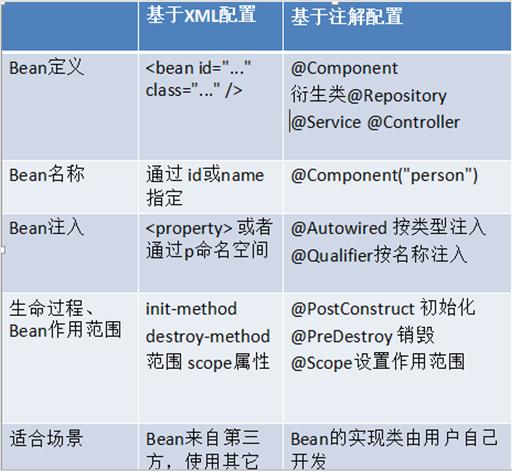Spring 基于注解的 IOC 配置
创建 spring 的 的 xml 配置 文件
<context:component-scan base-package="com.itheim"/> 指定创建容器时要扫描的包
<?xml version="1.0" encoding="UTF-8"?>
<beans xmlns="http://www.springframework.org/schema/beans"
xmlns:xsi="http://www.w3.org/2001/XMLSchema-instance"
xmlns:context="http://www.springframework.org/schema/context"
xsi:schemaLocation="http://www.springframework.org/schema/beans
http://www.springframework.org/schema/beans/spring-beans.xsd
http://www.springframework.org/schema/context
http://www.springframework.org/schema/context/spring-context.xsd">
<context:component-scan base-package="com.itheim"/>
</beans>
常用注解
用于创建对象的
@Component
相当于: <bean id="" class="">
作用:
把资源让 spring 来管理。相当于在 xml 中配置一个 bean。
属性:
value:指定 bean 的 id。如果不指定 value 属性,默认 bean 的 id 是当前类的类名。首字母小写
@Controller @Service @Repository
他们三个注解都是针对一个的衍生注解,他们的作用及属性都是一模一样的。
他们只不过是提供了更加明确的语义化。
@Controller :一般用于表现层的注解。
@Service :一般用于业务层的注解。
@Repository :一般用于持久层的注解。
细节:如果注解中有且只有一个属性 要赋值时是 ,且名称是 value ,value 在赋值是可以不写。
用于注入数据的
相当于: <property name="" ref=""><property name="" value="">
@Autowired
作用:
自动按照类型注入。当使用注解注入属性时,set方法可以省略。它只能注入其他 bean 类型。当有多个
类型匹配时,使用要注入的对象变量名称作为 bean 的 id,在 spring 容器查找,找到了也可以注入成功。找不到
就报错。
@Qualifier
作用:
在自动按照类型注入的基础之上,再按照 Bean 的 id 注入。它在给字段注入时不能独立使用,必须和
@Autowire 一起使用;但是给方法参数注入时,可以独立使用。
属性:
value:指定 bean 的 id。
@Resource
作用:
直接按照 Bean 的 id 注入。它也只能注入其他 bean 类型。
属性:
name:指定 bean 的 id。
@Value
作用:
注入基本数据类型和 String 类型数据的
属性:
value:用于指定值 value值的方式 ${jdbc.url}
用于改变作用范围的:
相当于: <bean id="" class="" scope="">
@Scope
作用:
指定 bean 的作用范围。
属性:
value:指定范围的值。
取值:singleton prototype request session globalsession
和生命周期相关的:( 了解)
相当于: <bean id="" class="" init-method="" destroy-method="" />
@PostConstruct
用于指定初始化方法
@PreDestroy
用于指定销毁方法
关于 Spring 注解和 XML 的选择问题
注解的优势:
配置简单,维护方便(我们找到类,就相当于找到了对应的配置)。
XML 的优势:
修改时,不用改源码。不涉及重新编译和部署。
Spring 管理 Bean 方式的比较:

案例
通过注解实现从数据库查询信息
bean.xml配置
<?xml version="1.0" encoding="UTF-8"?>
<beans xmlns="http://www.springframework.org/schema/beans"
xmlns:xsi="http://www.w3.org/2001/XMLSchema-instance"
xsi:schemaLocation="http://www.springframework.org/schema/beans
http://www.springframework.org/schema/beans/spring-beans.xsd">
<bean id="accountService" class="com.itheim.service.Imp.accountServiceImp">
<property name="dao" ref="dao"/>
</bean>
<bean id="dao" class="com.itheim.dao.Imp.accountDaoImp">
<property name="runner" ref="runner"/>
</bean>
<bean id="runner" class="org.apache.commons.dbutils.QueryRunner" scope="prototype">
<constructor-arg name="ds" ref="ds"/>
</bean>
<!-- 配置数据源-->
<bean id="ds" class="com.mchange.v2.c3p0.ComboPooledDataSource">
<property name="driverClass" value="com.mysql.jdbc.Driver"/>
<property name="jdbcUrl" value="jdbc:mysql://localhost:3306/eesy_mybatis"/>
<property name="user" value="root"/>
<property name="password" value="root"/>
</bean>
</beans>
使用Service注解配置管理资源
/**
* 账户的业务层实现类
* @author
* @Company
* @Version 1.0
*/
@Service("accountService")
public class accountServiceImp implements accountService {
private accountDao dao;
static {
System.out.println("service创建完成");
}
public void setDao(accountDao dao) {
this.dao = dao;
}
public List<Account> findAll() {
return dao.findAll();
}
public void Update(int id) {
dao.Update(id);
}
public void saveUser(Account account) {
dao.saveUser(account);
}
}
/**
* 账户的持久层实现类
* @author
* @Company
* @Version 1.0
*/
public class accountDaoImp implements accountDao {
private QueryRunner runner;
public void setRunner(QueryRunner runner) {
this.runner = runner;
}
public List<Account> findAll() {
try {
String sql="select * from account";
return runner.query(sql,new BeanListHandler<Account>(Account.class));
} catch (SQLException e) {
throw new RuntimeException(e);
}
}
public void Update(int id) {
try {
String sql="update account set money=? where id=? ";
runner.update(sql,7000,id);
} catch (SQLException e) {
throw new RuntimeException(e);
}
}
public void saveUser(Account account) {
try {
String sql="insert into account(money) values(?)";
runner.update(sql,account.getMoney());
} catch (SQLException e) {
throw new RuntimeException(e);
}
}
}
注意:
1、当我们使用注解注入时,set 方法不用写
编写测试类
@Test
public void springTest(){
ApplicationContext context=new ClassPathXmlApplicationContext("bean.xml");
accountService service = (accountService) context.getBean("accountService");
Account account = (Account) context.getBean("account");
List<Account> list = service.findAll();
System.out.println(list);
account.setMoney(6000);
service.saveUser(account);
}
pom.xml下的配置为
<dependencies>
<dependency>
<groupId>mysql</groupId>
<artifactId>mysql-connector-java</artifactId>
<version>5.1.6</version>
</dependency>
<!--导入spring依赖jar包-->
<dependency>
<groupId>org.springframework</groupId>
<artifactId>spring-context</artifactId>
<version>5.0.2.RELEASE</version>
</dependency>
<dependency>
<groupId>junit</groupId>
<artifactId>junit</artifactId>
<version>4.12</version>
</dependency>
<dependency>
<groupId>c3p0</groupId>
<artifactId>c3p0</artifactId>
<version>0.9.1.2</version>
</dependency>
<dependency>
<groupId>commons-dbutils</groupId>
<artifactId>commons-dbutils</artifactId>
<version>1.7</version>
</dependency>
</dependencies>
Spring 基于注解的 IOC 配置的更多相关文章
- 10 Spring框架--基于注解的IOC配置
1.工程环境搭建 2.基于注解的IOC配置 IOC注解的分类 (1)用于创建对象的 他们的作用就和在XML配置文件中编写一个<bean>标签实现的功能是一样的@Component: 作用: ...
- spring基于注解的IoC以及IoC的案例
1.Spring中IoC的常用注解 1.1明确: (1)基于注解的配置和xml的配置要实现的功能都是一样的,都是要降低程序之间的耦合,只是配置的形式不一样 2.案例:使用xml方式和注解方式实现单表的 ...
- 阶段3 2.Spring_08.面向切面编程 AOP_9 spring基于注解的AOP配置
复制依赖和改jar包方式 src下的都复制过来. 复制到新项目里了 bean.xml里面复制上面一行代码到下面.把aop改成context. 配置spring容器创建时要扫描的包 Service的配置 ...
- 基于注解的IOC配置
1 明确 注解配置和XML配置要实现的功能都是一样的,都是要降低程序间的耦合.只是配置的形式不一样. 关于实际的开发中到底是使用XML还是注解,每家公司有着不同的习惯.具体问题具体分析. 2 环境搭建 ...
- spring的基于注解的IOC配置
1.配置文件配置 <?xml version="1.0" encoding="UTF-8"?><beans xmlns="http: ...
- spring基于注解的IOC
曾经的XML配置: <bean id="accountService" class="com.itheima.service.impl.AccountService ...
- 缓存初解(五)---SpringMVC基于注解的缓存配置--web应用实例
之前为大家介绍了如何使用spring注解来进行缓存配置 (EHCache 和 OSCache)的简单的例子,详见 Spring基于注解的缓存配置--EHCache AND OSCache 现在介绍一下 ...
- 缓存初解(三)---Spring3.0基于注解的缓存配置+Ehcache和OScache
本文将构建一个普通工程来说明spring注解缓存的使用方式,关于如何在web应用中使用注解缓存,请参见: Spring基于注解的缓存配置--web应用实例 一.简介 在spring的modules包中 ...
- 8 -- 深入使用Spring -- 4...5 AOP代理:基于注解的“零配置”方式
8.4.5 基于注解的“零配置”方式 AspectJ允许使用注解定义切面.切入点和增强处理,而Spring框架则可识别并根据这些注解来生成AOP代理.Spring只是使用了和AspectJ 5 一样的 ...
随机推荐
- Windows Socket编程精华《TCP通信服务器》
1.网络中进程之间如何通信? 首要解决的问题是如何唯一标识一个进程,否则通信无从谈起!在本地可以通过进程PID来唯一标识一个进程,但是在网络中这是行不通的.其实TCP/IP协议族已经帮我们解决了这个问 ...
- 03 flask源码剖析之threading.local和高级
03 threading.local和高级 目录 03 threading.local和高级 1.python之threading.local 2. 线程唯一标识 3. 自定义threading.lo ...
- hihoCoder 1051 补提交卡 最详细的解题报告
题目来源:补提交卡 解题思路:假设未提交程序的天数为:a1,a2,....,an,补交的张数为M.依次从a1,a2,....,an中去掉连续的 K 天(0<=K<=M),然后再来计算剩余数 ...
- Java对象与Json字符串的转换
Java对象与Json字符串的转换 JSON是一种轻量级的数据交换格式,常用于前后端的数据交流 后端 : 前端 Java对象 > JsonString Java对象 < jsonStrin ...
- 网页排名算法PagaRank
网页排名算法PageRank PageRank,网页排名,又叫做网页级别.是一种利用网页之间的超链接数据进行计算的方法.它是由Google的两位创始人提出的. 对于用户而言,网页排名一般是比较主观的, ...
- 从Excel(CSV)文件导入数据到Oracle
步骤: 1.准备数据:在excel中构造出需要的数据2.将excel中的数据另存为文本文件(有制表符分隔的)3.将新保存到文本文件中的数据导入到pl*sql中在pl*sql中选择tools--text ...
- Python Ethical Hacking - Malware Analysis(4)
DOWNLOAD_FILE Download files on a system. Once packaged properly will work on all operating systems. ...
- Nginx使用SSL模块配置https
背景 开发微信小程序,需要https域名,因此使用Nginx的SSL模块配置https 步骤 一.去域名管理商(如腾讯云.阿里云等)申请CA证书 二.在Nginx中配置,一般情况下域名管理商会提供配置 ...
- Windows下安装Python 3.X 版本
一. Python下载 Python官方下载地址 演示下载的版本为Python 3.8.3 ,你可以根据自己的选择安装其他版本的Python 二. Python 安装 下载完安装包双击安装时出错(Wi ...
- mysql查看各表占磁盘空间
select TABLE_NAME, concat(truncate(data_length/1024/1024,2),' MB') as data_size, concat(truncate(ind ...
